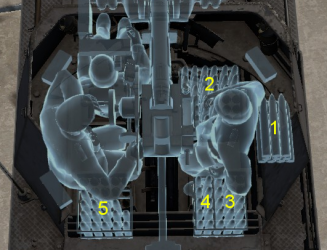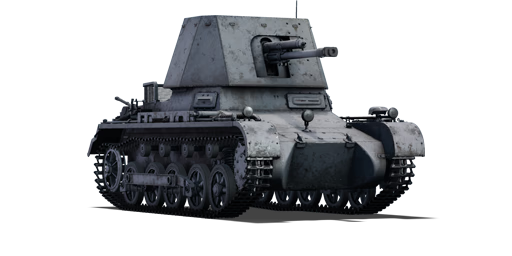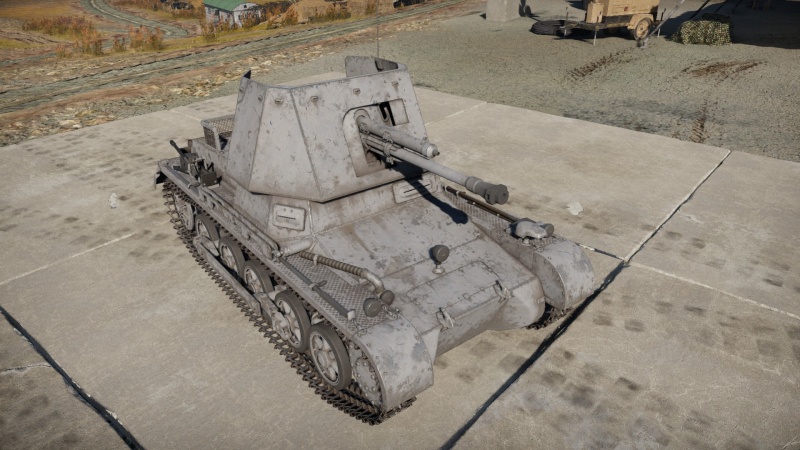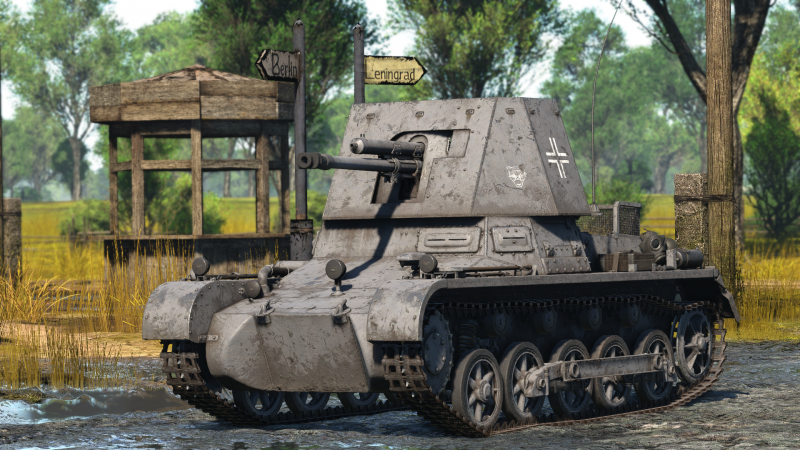Panzerjager I
Contents
Description
The Panzerjäger I (4,7 cm Pak (t) (Sfl.) auf Pz.Kpfw.I (Sd.Kfz.101) ohne Turm) was the first self-propelled gun adopted by Nazi Germany. The SPG had a chassis from the obsolete Pz.I, from which the turret was removed and the hull partially cut down; onto this an open-topped, rear fighting compartment was mounted. The vehicle was armed with a 47 mm captured Czech Skoda gun, designed in 1937-1938, which received the designation 4,7 cm PaK(t) in the Wehrmacht. The Panzerjäger I was produced from 1940 to 1941, during which period 202 units of the self-propelled guns were manufactured. It actively participated in the French, North African and Eastern campaigns, where it was used for ambushing fire and proved effective against enemy light tanks, but was practically helpless against medium and heavy tanks. In addition, in autumn/winter 1941, the self-propelled gun showed complete unsuitability for the climate of the Soviet Union, where it constantly broke down or got bogged down in mud and snow. The Panzerjäger I participated in combat operations until mid-1943.
Introduced in Update 1.57 "Battle March", the Panzerjäger I has a sufficiently powerful gun for its battle rating, but also an open fighting compartment, which makes it quite vulnerable to HE shells, artillery, and enemy aircraft.
General info
Survivability and armour
Armour type:
- Rolled homogeneous armour
| Armour | Front (Slope angle) | Sides (Slope angle) | Rear | Roof |
|---|---|---|---|---|
| Hull | 13 mm (18°) Front plate 13 mm (72-75°) Front glacis 13 mm (26°) Lower glacis |
13 mm | 13 mm | 8 mm |
| Superstructure | 14 mm (26°) | 14 mm (15-18°) | N/A | N/A |
Notes:
- Suspension wheels and bogies are 10 mm thick while the tracks are 15 mm thick.
Any enemies at this rank can pierce your armour. However, the biggest threats are the SPAA vehicles due to their higher rate of fire with effective weapons that will absolutely rip apart the vehicle. Airplanes too are a concern, and artillery is very deadly.
Mobility
| Game Mode | Max Speed (km/h) | Weight (tons) | Engine power (horsepower) | Power-to-weight ratio (hp/ton) | |||
|---|---|---|---|---|---|---|---|
| Forward | Reverse | Stock | Upgraded | Stock | Upgraded | ||
| Arcade | 46 | 5 | 6.4 | 142 | 191 | 22.19 | 29.84 |
| Realistic | 43 | 5 | 88 | 100 | 13.75 | 15.63 | |
Modifications and economy
Armaments
Main armament
| 47 mm Pak.(t)(Sf.) | Turret rotation speed (°/s) | Reloading rate (seconds) | |||||||||||
|---|---|---|---|---|---|---|---|---|---|---|---|---|---|
| Mode | Capacity | Vertical | Horizontal | Stabilizer | Stock | Upgraded | Full | Expert | Aced | Stock | Full | Expert | Aced |
| Arcade | 86 | -8°/+10° | ±15° | N/A | 10.6 | 14.6 | 17.8 | 19.6 | 20.9 | 3.9 | 3.5 | 3.3 | 3.0 |
| Realistic | 7.1 | 8.4 | 10.2 | 11.3 | 12.0 | ||||||||
Ammunition
| Penetration statistics | |||||||
|---|---|---|---|---|---|---|---|
| Ammunition | Type of warhead |
Penetration @ 0° Angle of Attack (mm) | |||||
| 10 m | 100 m | 500 m | 1,000 m | 1,500 m | 2,000 m | ||
| Pzgr.36(t) | APC | 87 | 82 | 66 | 50 | 38 | 29 |
| Pzgr.40 | APCR | 119 | 110 | 77 | 50 | 32 | 21 |
| Shell details | ||||||||||||
|---|---|---|---|---|---|---|---|---|---|---|---|---|
| Ammunition | Type of warhead |
Velocity (m/s) |
Projectile mass (kg) |
Fuse delay (m) |
Fuse sensitivity (mm) |
Explosive mass (TNT equivalent) (g) |
Ricochet | |||||
| 0% | 50% | 100% | ||||||||||
| Pzgr.36(t) | APC | 775 | 1.65 | 1.2 | 9 | 15 | 48° | 63° | 71° | |||
| Pzgr.40 | APCR | 1,080 | 0.83 | - | - | - | 66° | 70° | 72° | |||
Ammo racks

| Full ammo |
1st rack empty |
2nd rack empty |
3rd rack empty |
4th rack empty |
5th rack empty |
Visual discrepancy |
|---|---|---|---|---|---|---|
| 86 | 76 (+10) | 42 (+44) | 27 (+59) | 17 (+69) | 0 (+86) | No |
Notes:
- Racks disappear after you've fired all shells in the rack.
- Turret empty: 76 (+10) shells.
- Right flank empty: 17 (+69) shells.
Usage in battles
Although virtually unarmoured, the Panzerjäger I can be used in a head-on manner. However, this is not recommended. It is much better to snipe or ambush the enemy. Its gun may have a good Rate of Fire, but many other guns of its rank, such as the British 2-pounder, will reload faster than you. However, your gun is extremely powerful for its rank, which means you will go through almost anything, so there is no need to throw yourself in front of the enemy.
While the gun can be sufficient and one-shot many enemies from light to medium tanks, more heavily armoured tanks will be a problem unless using the APCR ammunition. The common enemies to be concerned about are the B1 bis, B1 ter, and Matilda Mk II if the Panzerjäger I is used as the highest-BR option in your line-up. The B1 bis is only frontally penetrable on the turret ring or the exposed breech of the hull-mounted 75 mm. The B1 ter is only penetrable in flank shots with APCR or a very lucky turret ring hit. The Matilda is only frontally penetrable on the turret ring or demands use of APCR.
Pros and cons
Pros:
- Large ammo reserve of 86 rounds
- Agile vehicle, with a good power-to-weight ratio
- One of the best guns in Rank I, can penetrate most things it comes up against and destroy them in 1-2 penetrating hits due to HE filler
- Access to APCR ammunition for certain targets that the APC round cannot penetrate reliably
- Good ballistics for 47 mm, can be used effectively at long range
- Narrow, can fit in tight spaces
- Fast reload
Cons:
- Tall profile, bigger target
- Very thin armour, maximum of 15 mm
- Crew operating the gun have no armour protection in the top and rear of their position
- Not a lot of horsepower, poor for towing downed allied vehicles
- No defensive machine gun, open-topped SPAA can be a problem
- Gun quickly becomes obsolete in uptiers, it does not cope well with sloped armour
- Prone to flipping over when making turns at high speed (especially in arcade with upgrades to mobility)
History
Development
The heavily armoured tanks in Allied inventory was considered a threat to the German armoured forces, which consisted of mostly 3.7 cm gun that were ineffective. To counter these threats, the Germans sought for a vehicle able to mount a bigger gun able to fight these tanks. It was found that they could convert obsolete chassis designs like the Panzer I to mount the guns, thus saving the design process of developing a new vehicle for the role. The Czech 4.7 cm Pak(t) anti-tank gun was chosen for this task, and was mounted on a converted Panzer I chassis with the turret removed, a gun shield was used for the mount of the gun. Between 1940 to 1941, 202 Panzer Is were converted by Alkett and Deutz AG to these tank destroyers, designated the "Panzerjäger I", the first of its kind of tank destroyers in the war.
Combat usage
The Panzerjäger I were organised in anti-tank battalions, each having three companies with nine vehicles each. Five battalions in the war were equipped with the tank destroyer. The first usage of the Panzerjäger I was in the Battle of France, where four battalions were committed. Though, only Anti-Tank Battalion 521 saw service from the beginning to the end as the other four were still in training when the campaign started. The opinion of the crew of these vehicles were positive, saying that the weapon was adequate to distances up to 600 m if the enemy had 45 to 50 mm of armour. However, the crew also say that the ability to observe the battle in the vehicle was terrible, the crew had to look over the shield to see what is ahead, risking themselves to injury to the head.
After the Battle of France, the Panzerjäger I's in Anti-Tank Battalion 605 were sent to the North African Campaign, though only 3 of the 27 vehicles made it as the transport freighter Castellon carrying the rest was sunk. The battalion was in full strength during the British offensive in Operation Crusader in November 1941, to which they lost 13 vehicles in the battle. Battle experience praise the accuracy the vehicle provides, but state that the vehicles were too weak for the combat conditions and the gun didn't have enough penetration in long distance. With an APCR round, it was found it could destroy the venerable Matilda infantry tanks at distance of around 400 m. The battalion continued this battle of attrition with reinforcement and losses that during the Second Battle of El Alamein in October 1942, only 11 Panzerjäger Is were left in the battalion. The last two replacement vehicle were sent to the battalion in November 1942. In Operation Barbarossa, five anti-tank battalions were equipped with the Panzerjäger Is, which made up a total of 135 vehicles. The combat experience was subpar, while the Panzerjäger I had a good effective range of up to 1,000 to 1,200 m, but the high profile of the vehicle presented a big target to enemy anti-tank weapons and artillery, even shrapnel from high-explosive shells could penetrate the thin armour. Many Panzerjäger I's were destroyed and by the Fall of 1942, many battalions reported to be under equipped for further action and were disbanded. At this point, better anti-tank weaponry and vehicles were more accessible and replaced the Panzerjäger I in service, notably the Marder series.
Media
- Skins
- Videos
See also
- Vehicles equipped with the same chassis
- Similar German vehicles
- Other vehicles of similar configuration and role
External links
- [Development] The Panzerjäger I, and announcing a branch of German SPGs with open cabins
- [Profile] Panzerjäger I - The first German Tank Hunter
- Wikipedia - Panzerjäger I
- Tanks Encyclopedia - 4,7 cm PaK (t) (Sfl) auf Pz.Kpfw.I (Sd.Kfz.101) ohne Turm, Panzerjäger I
| Germany tank destroyers | |
|---|---|
| Pz. I Derivatives | Panzerjäger I |
| Pz. II Derivatives | 15cm sIG 33 B Sfl |
| Pz. 38(t) Derivatives | Marder III · Marder III H · Jagdpanzer 38(t) |
| Pz. III Derivatives | StuG III A · StuG III F · StuG III G · StuH 42 G |
| Pz. IV Derivatives | Jagdpanzer IV · Panzer IV/70(A) · Panzer IV/70(V) · Dicker Max · Nashorn · Brummbär · VFW |
| Pz. V Derivatives | Jagdpanther G1 · Bfw. Jagdpanther G1 |
| Pz. VI Derivatives | Sturer Emil · Elefant · Ferdinand · 38 cm Sturmmörser · Jagdtiger |
| Wheeled/Half-track | 8,8 cm Flak 37 Sfl. · Sd.Kfz.251/9 · Sd.Kfz.251/10 · Sd.Kfz.251/22 · Sd.Kfz.234/3 · Sd.Kfz.234/4 · 15 cm Pz.W.42 |
| ATGM Carrier | RakJPz 2 · RakJPz 2 (HOT) · Wiesel 1A2 |
| Other | Waffenträger · M109G · JPz 4-5 · Raketenautomat · VT1-2 |






